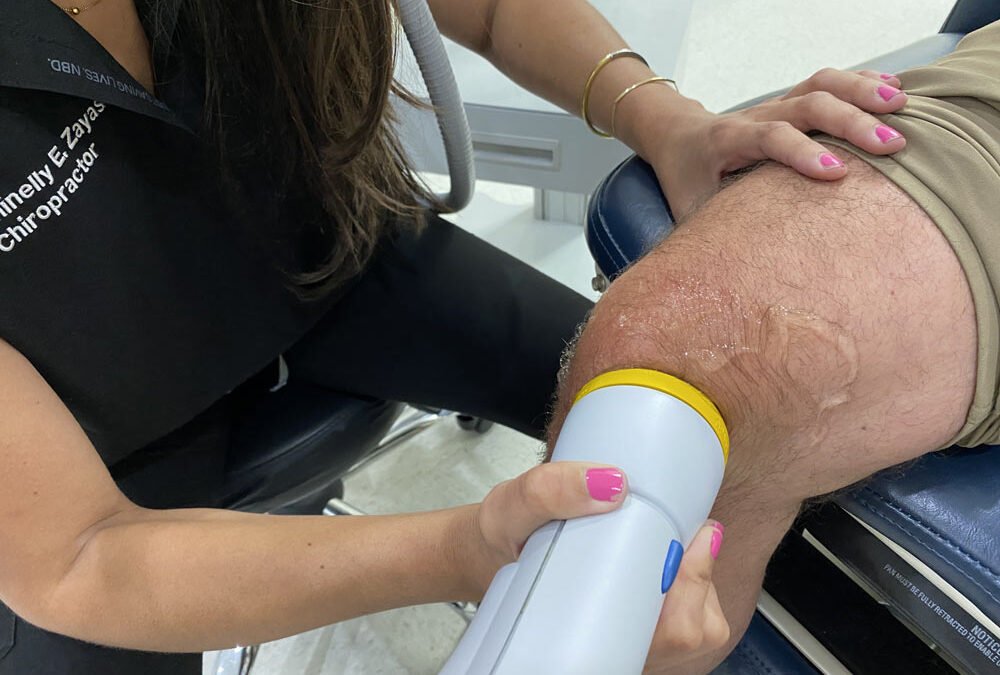In the quest for effective pain management, individuals often find themselves exploring a variety of treatment options, ranging from medications to physical therapy. One innovative approach is softwave therapy. This non-invasive and cutting-edge technology harnesses the power of acoustic waves to target and alleviate pain caused by various musculoskeletal conditions. If you’re seeking a pain management solution that doesn’t rely on medication or surgery, this article will serve as a guide to help you determine whether softwave therapy is the right choice to alleviate your discomfort and enhance your quality of life.
What is Softwave Therapy?
Softwave Therapy is an advanced medical technique designed to address a wide range of musculoskeletal pain conditions. This innovative approach utilizes high-energy acoustic waves to target areas of discomfort and stimulate the body’s natural healing processes. Unlike invasive surgical procedures or reliance on long-term medication, Softwave Therapy is non-invasive, making it an attractive option for those seeking pain relief without the associated risks and downtime.
At its core, it works by delivering acoustic waves directly to the affected area, promoting increased blood flow and cellular regeneration. This process accelerates the body’s natural healing mechanisms, reducing pain and inflammation. It’s particularly effective for addressing conditions like tendinitis, plantar fasciitis, tennis elbow, and even chronic back pain. One of its significant advantages is its ability to target the source of pain rather than merely masking the symptoms, making it a potential long-term solution for those suffering from chronic discomfort.
It is known for its minimal side effects and shorter recovery times compared to many surgical interventions. Patients can typically resume their daily activities shortly after treatment, making it a practical choice for individuals looking to maintain their active lifestyles while managing pain effectively.
Conditions Treatable with Softwave Therapy
Softwave therapy has demonstrated effectiveness in addressing a wide range of musculoskeletal conditions and chronic pain disorders. Whether you’re dealing with a sports-related injury or a persistent joint issue, It may offer relief. Here are some of the common conditions that can be treated with this innovative therapy:
- Tendinitis: Reduce pain and inflammation associated with various forms of tendinitis, including Achilles tendinitis, rotator cuff tendinitis, and patellar tendinitis.
- Plantar Fasciitis: Individuals suffering from the stabbing heel pain of plantar fasciitis often find relief through Softwave Therapy, which targets the inflamed tissue in the foot.
- Tennis and Golfer’s Elbow: Alleviate the pain and discomfort associated with these overuse injuries by stimulating the body’s natural healing processes.
- Chronic Back Pain: For those enduring chronic back pain due to muscle spasms or degenerative disc disease, softwave therapy offers a non-invasive approach to pain management.
- Trigger Points: Effectively target trigger points or knots in muscles, providing relief from tension and pain.
- Calcific Rotator Cuff Tendinopathy: This condition involves calcium deposits in the shoulder tendons, leading to pain and limited mobility. Softwave Therapy can break down these deposits, reducing discomfort.
- Hip Pain: Address hip pain caused by various factors, including bursitis and hip labral tears.
- Scar Tissue: It can also help break down scar tissue in muscles and ligaments, improving range of motion and reducing pain associated with old injuries.
Keep in mind that the effectiveness of Softwave Therapy may vary depending on the individual and the severity of the condition. It’s essential to consult with a qualified healthcare professional to determine whether softwave therapy is a suitable treatment option for your specific pain condition.
Benefits of Softwave Therapy
Softwave Therapy offers several notable benefits as a non-invasive pain management option. These advantages have contributed to its growing popularity among individuals seeking relief from musculoskeletal pain and injuries. Here are some of the primary benefits of Softwave Therapy:
- Non-Invasive: A non-surgical and non-invasive treatment, meaning there are no incisions or anesthesia required. This reduces the risk of complications and eliminates the need for lengthy recovery periods.
- Minimal Side Effects: Patients typically experience minimal side effects, such as mild discomfort or bruising, which are temporary and subside quickly. This makes it a well-tolerated option for pain management.
- No Medication Dependency: Unlike some pain management approaches that rely on long-term medication, softwave therapy addresses the underlying causes of pain, reducing the need for ongoing medication use.
- Quick Sessions: Treatment sessions are relatively short, often lasting around 15 to 30 minutes, making it convenient for individuals with busy schedules.
- Targeted Pain Relief: Softwave therapy is known for its ability to target the source of pain, rather than masking symptoms. This can lead to more lasting pain relief and improved mobility.
- Enhanced Healing: The therapy stimulates the body’s natural healing processes, promoting tissue repair and regeneration, which can result in long-term improvements.
- Versatility: It can be applied to various musculoskeletal conditions, from tendinitis to muscle injuries, offering a versatile solution for a wide range of patients.
- Reduced Downtime: Patients typically experience little to no downtime after each session, allowing them to return to their daily activities quickly.
- High Success Rates: Many individuals report significant improvements in pain and mobility after Softwave Therapy, with success rates varying depending on the condition and patient responsiveness.
- Avoidance of Surgery: It can serve as an alternative to surgical procedures for certain conditions, sparing patients the risks and recovery associated with surgery.
These benefits make Softwave Therapy an attractive option for individuals seeking effective pain management while minimizing the drawbacks of more invasive or medication-dependent approaches. However, it’s crucial to consult with a healthcare professional to determine if Softwave Therapy is the right choice for your specific pain condition.
Is Softwave Therapy Right for You?
Determining whether Softwave Therapy is the right choice for your pain management needs involves several considerations. While Softwave Therapy offers several benefits and can effectively address various musculoskeletal conditions, it may not be suitable for everyone. Here are some factors to help you evaluate whether Softwave Therapy aligns with your specific situation:
Firstly, the type and severity of your pain condition play a crucial role in deciding if Softwave Therapy is appropriate. Softwave Therapy is most effective for conditions involving tendons, muscles, and ligaments, such as tendinitis, plantar fasciitis, and rotator cuff injuries. If you have been diagnosed with one of these conditions, Softwave Therapy may be a promising option. However, it may not be as effective for pain caused by other factors like nerve compression or spinal issues.
Your overall health and medical history also influence the suitability of Softwave Therapy. Certain medical conditions or medications may affect your eligibility for this treatment. It’s essential to discuss your medical history with a healthcare professional to determine if you are a suitable candidate for Softwave Therapy.
Your treatment goals and preferences should be considered. Softwave Therapy offers non-invasive pain relief with minimal side effects and no medication dependency. If you prefer a non-surgical approach that promotes natural healing and quick recovery, Softwave Therapy aligns well with these preferences. However, if you have a strong aversion to medical procedures or prefer other forms of pain management, discussing your options with a healthcare provider is essential.
The decision to pursue Softwave Therapy should be made in consultation with a qualified healthcare professional who can assess your condition, medical history, and treatment goals. They can provide personalized guidance to determine if softwave therapy is the right choice for your pain management needs or if alternative treatments would be more suitable.
The Treatment Process
Understanding what to expect during a Softwave Therapy session can help you prepare for this non-invasive pain management option. Here’s an overview of the treatment process:
Softwave therapy sessions are typically conducted in a clinical setting by trained healthcare professionals, often chiropractors, physiotherapists, or sports medicine specialists. The process begins with a thorough assessment of your specific pain condition and medical history to ensure that Softwave Therapy is a suitable choice for you.
Once it’s determined that you’re a candidate for this treatment, you’ll be positioned comfortably, and a specialized handpiece will be applied to the targeted area. This handpiece delivers focused acoustic waves to the affected tissues. During the treatment, you may feel a series of pulsations or tapping sensations, but most patients find the procedure to be generally well-tolerated.
The duration of each session typically ranges from 15 to 30 minutes, depending on the condition being treated. After the session, you can usually resume your daily activities without significant downtime. Some individuals experience mild discomfort, redness, or swelling at the treatment site, but these side effects are generally short-lived and should subside within a few days. Multiple sessions may be required for optimal results, with the exact number determined by your healthcare provider based on your progress and response to treatment.
Overall, softwave therapy offers a straightforward and convenient treatment process that can effectively address a variety of musculoskeletal conditions. However, it’s essential to consult with a qualified healthcare provider to discuss your specific needs, treatment plan, and expected outcomes.
Contact Rittenhouse Square Chiropractic
If you’re considering softwave therapy as part of your pain management plan or seeking further information about this innovative treatment, don’t hesitate to contact us at Rittenhouse Square Chiropractic. Our dedicated team of chiropractors and healthcare professionals is here to provide expert guidance and personalized care. We can help assess your condition, discuss whether softwave therapy is the right fit for your specific pain management needs, and create a customized treatment plan tailored to your goals.

